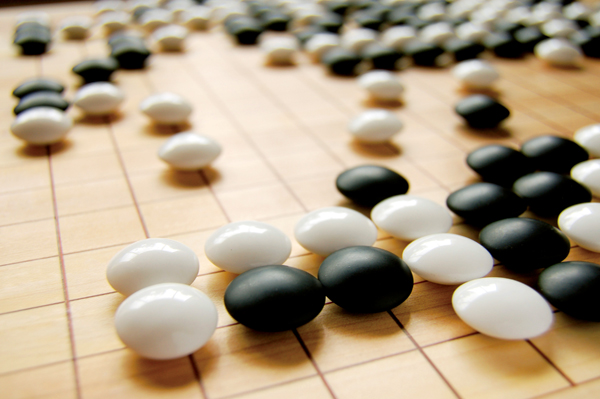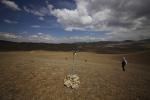
- Updated 2024.10.23 18:06
- All Articles
-
member
icon
-
facebook
cursor
-
twitter
cursor
|
NewsSports |
A quick guide to essential concepts and terms of baduk |
|
Rules of play: The board is lined 19x19 and begins empty. Black plays first, and you place stones on intersections. A “pae” is two alternating single-stone captures that repeat the original board position in which the first player must wait a turn before returned to take the opponent’s stone. If all four lines around a stone or group of stones are surrounded by the opponent’s stones, those stones are “dead” and removed the from board. There are three distinct stages: opening, middle and end game. Play ends when there are no more viable moves. Dead stones are removed and count against territory, which are your unfilled intersections. The one with the most territory is the winner.
Note that a lot of the English terminology in baduk is taken from Japan, the nation that first introduced the game to the West (for a long historical reason we can’t get into here). Thus the game is called “go” or “igo” in English. In this article we use the Korean, baduk. In Chinese, it is “wei chi.”
Jeongseok (pattern, formula, standard move, “correct stones”; Jpn: Joseki) Like chess, there are thousands of standard reactions to an opponent’s move. These have been collected in books that may be memorized and internalized.
Jip (an open intersection or point, “house”; Jpn: Me, “eye”) A group of stones needs at least two “eyes” to live. Since your opponent has only one stone per turn, a group with two “eyes” cannot be killed even if completely surrounded.
Pae (two alternating single-stone captures that repeat the original board position in which the first player must wait a turn before returned to take the opponent’s stone; Jpn: Ko)
Handicap: Playing first gives a natural advantage. For players of roughly equal levels, 5.5 points are awarded to white. A weaker player taking on a stronger one will receive between one and nine stones placed strategically on the board at the start of the game.
Eight prime baduk concepts one must master:
Matbogi (equivalence, “seeing together”; Jpn: Miai) Two points that are related such that if a player makes one move, the opponent can select the other. Often these moves are not urgent, since there is a state of equilibrium. Often the game will switch directions, and players will direct their attention to a battle on another part of the board.
Mat (potential, momentum, “taste”; Jpn: Aji) Taste lingers. A particular move may have good or bad ramifications many moves later. Each stone or groups of stones have both a present and future relationship with many others all over the board. The game follows an ever-changing flow of potentialities between stones, groups of stones and their relative locations.
Gangyo (forcing move; Jpn: Kikashi) Since players take alternating turns, at points in the game, a player must answer the other in order to avoid disaster. Momentum of this kind can sometimes be maintained for many moves — rendering the opponent helpless but to “follow the lead.” One trick to gangyo is to play the move at the best possible time for maximum effect. One doesn’t want to squander such an advantageous tactic.
Saeryeok (thickness, strength, “few or no weak points”; Jpn: Saeryoku, atsumi) A high-level concept based on an overwhelming presence of stones that prevent opponents from utilizing gangyo. In the initial stages of the game it is crucial to build strong groups with a maximally-efficient distribution of stones just as much as it crucial to gain territory.
Eunghyeong (inefficient use or overconcentration of stones, “frozen shape”; Jpn: Korigatachi) Again, since players take alternating turns, to use one’s turn inefficiently is to play poorly.
Ssabareum (efficient or light handling, “development”; Jpn: Sabaki) The ability to quickly react to danger while building one’s territory — or in the worst case scenario to be able to build two “eyes” so that the group of stones cannot be killed, even if surrounded.
Bakkwochigi (exchange of territory, stones; Jpn: Furikawari) The sacrificing or exchanging of stones or territory, often with a larger plan in place, to benefit at some later stage of the game.
Eungsutajin (probing, forcing an opponent to fix shape; Jpn: Yosumiru) Somewhat similar to gangyo, it is a move which helps your position while forcing your opponent to fix their own, often before they have planned to, thus disturbing their immediate game plan.
|
|
|
|
|
|
|
 Todd Thacker의 다른기사 보기 Todd Thacker의 다른기사 보기 |
|
ⓒ Jeju Weekly 2009 (http://www.jejuweekly.net)
All materials on this site are protected under the Korean Copyright Law and may not be reproduced, distributed, transmitted, displayed, published without the prior consent of Jeju Weekly. |
|
|
|
|
| Jeju-Asia's No.1 for Cruise |
|
|
|
Title:The jeju Weekly(제주위클리) | Mail to editor@jejuweekly.net | Phone: +82-64-724-7776 Fax: +82-64-724-7796
#503, 36-1, Seogwang-ro, Jeju-si, Jeju-do, Korea, 63148
Registration Number: Jeju, Ah01158(제주,아01158) | Date of Registration: November 10,2022 | Publisher&Editor : Hee Tak Ko | Youth policy: Hee Tak Ko
Copyright ⓒ 2009 All materials on this site are protected under the Korean Copyright Law and may not be reproduced, distributed, transmitted, displayed, published
without the prior consent of jeju weekly.com.

|




















